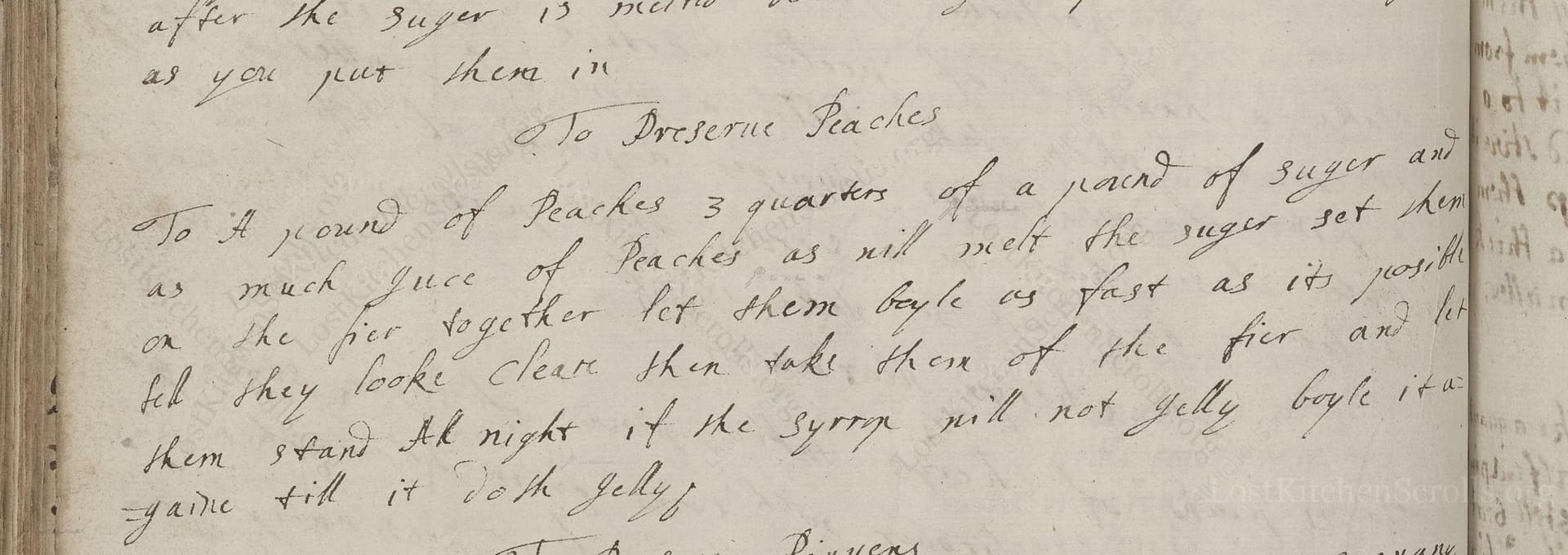To Preserve Peaches
From the treasured pages of Receipts in cookery and medicine 1700
Unknown Author

To Preserve Peaches
"To a pound of Peaches 3 quarters of a pound of suger set them as much Juce of Peaches as will melt the suger set them on the fier let them boyle as fast as its posible let them stand all night then take them of the fier and lett them boyle againe till it doth jelly if the syrrope will not jelly boyle it againe."
Note on the Original Text
The recipe is written as a set of instructions rather than a list of quantities and steps, relying on the cook’s existing kitchen experience. Spelling follows early-modern conventions (e.g., ‘boyle’ for ‘boil,’ ‘fier’ for ‘fire,’ ‘syrrope’ for ‘syrup’), and punctuation is sparse, with steps often running into each other. Measurements are by weight (pounds, quarters), with the proportion of sugar to fruit somewhat lower than later Victorian recipes—a sign of both evolving tastes and fluctuating sugar prices.

Title
Receipts in cookery and medicine 1700 (1700)
You can also click the book image above to peruse the original tome
Writer
Unknown
Era
1700
Publisher
Unknown
Background
Step into the kitchen of the early 18th century, where this charming culinary manuscript tempts tastebuds with recipes and secrets from a bygone era. A delicious journey for both the curious cook and the history lover.
Kindly made available by
Folger Shakespeare Library
This recipe is drawn from around 1700, a time when sugar preserves were the height of both luxury and practicality in England. Before refrigeration, seasonal fruits like peaches were scarce and often eaten fresh only by the wealthy, who could afford sugar in large quantities. Preserving peaches captured their fragrance and flavor for months to come, transforming summer's bounty into a winter delicacy. The recipe’s source—an English household manuscript from circa 1700—reflects the rise of printed and written cookbooks, signaling a growing interest in domestic management and culinary technique among upper- and middle-class households.

In the early 18th century, this preserve would have been made in large copper or brass preserving pans set over open hearth fires or on grates. Cooks would use wooden spoons for stirring and ladling, and possibly linen cloth to strain peach juice. Preserves were typically stored in earthenware jars, covered with parchment or bladder to seal them against air. Today, you can use a heavy pot, a ladle, a small sieve for juicing, and glass preserving jars with tight lids.
Prep Time
30 mins
Cook Time
30 mins
Servings
8
We've done our best to adapt this historical recipe for modern kitchens, but some details may still need refinement. We warmly welcome feedback from fellow cooks and culinary historians — your insights support the entire community!
Ingredients
- 2.2 lbs ripe peaches (yellow or white-fleshed)
- 1.65 lbs granulated sugar
- 3.5 fl oz fresh peach juice (extracted by mashing and straining peaches, can substitute with commercial peach juice if necessary)
Instructions
- To preserve peaches as in the 1700s, start with 2.2 lbs of ripe peaches.
- For each 2.2 lbs, prepare 1.65 lbs of granulated sugar.
- Extract peach juice by peeling and gently mashing or blending a few peaches, then straining the juice.
- Place the peach pieces in a heavy-bottomed pot.
- Pour over the 1.65 lbs sugar and add enough fresh peach juice to just moisten the sugar—around 3.5 fl oz, or until the sugar begins to dissolve.
- Heat over medium-high, bringing quickly to a rapid boil.
- Boil as vigorously as possible (take care to stir regularly to prevent sticking) until peaches are translucent and syrupy, about 10-12 minutes.
- Remove from the heat and let everything rest overnight.
- The next day, bring peaches and syrup back to a boil.
- Continue boiling until the syrup thickens and “jellies” (reaches a setting point, about 221°F on a sugar thermometer or until a little syrup gels on a cold plate).
- If it doesn’t jelly, boil again until it does.
- Spoon preserved peaches and syrup into sterilized jars and seal while hot.
Estimated Calories
160 per serving
Cooking Estimates
You will spend time peeling and preparing peaches, then cooking them in two separate stages. The first cook takes about 12 minutes, plus overnight resting, and the second cook is around 15 minutes until the syrup jellies. Each serving is about 160 calories, based on dividing the batch into 8 portions.
As noted above, we have made our best effort to translate and adapt this historical recipe for modern kitchens, taking into account ingredients nowadays, cooking techniques, measurements, and so on. However, historical recipes often contain assumptions that require interpretation.
We'd love for anyone to help improve these adaptations. Community contributions are highly welcome. If you have suggestions, corrections, or cooking tips based on your experience with this recipe, please share them below.
Join the Discussion
Rate This Recipe
Dietary Preference
Main Ingredients
Culinary Technique

Den Bockfisch In Einer Fleisch Suppen Zu Kochen
This recipe hails from a German manuscript cookbook compiled in 1696, a time whe...

Die Grieß Nudlen Zumachen
This recipe comes from a rather mysterious manuscript cookbook, penned anonymous...

Ein Boudain
This recipe comes from an anonymous German-language manuscript cookbook from 169...

Ein Gesaltzen Citroni
This recipe, dating from 1696, comes from an extensive anonymous German cookbook...
Browse our complete collection of time-honored recipes



